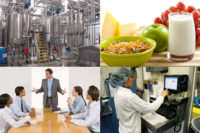When we think of terrorist targets, skyscrapers and monuments probably come to mind before the national food supply. But researchers at Georgia Tech’s School of Industrial and Systems Engineering (ISyE) warn that the food supply is vulnerable and have urged the government and industry stakeholders to develop a plan to protect against biological, chemical, physical or radioactive contamination of the food supply.
To help address the threat, researchers are developing a model of food supply chains that can be used in the formulation of a protection plan. Associate Professor Alan Erera leads the six-year, $1 million research project that began in 2010.
“Our goal is to help make sure food products are safe from farm to fork by identifying food supply chain designs that ensure a high level of system productivity while mitigating the risks posed by intentional attacks on the food supply chain,” says Erera.
The model’s first application determines vulnerabilities in the supply chain for liquid eggs. Researchers tested adaptability scenarios including reducing the amount of liquid egg in each tank, housing the liquid egg in several facilities instead of just one, increasing the frequency of tank cleanings, changing the timing of certain activities and increasing security.
Each strategy has its advantages and drawbacks. For example, while reducing the amount of egg per container could decrease the total potential contamination, it would likely drive production costs higher. And while spreading operations out between multiple smaller facilities could also decrease the potential for large-scale contamination, production and security costs would tick up.
Erera’s team wants to find a way to significantly mitigate risk in the supply chain with only a small investment. To do that, they will continue to improve the model’s accuracy by studying other food products. Eventually, researchers hope to make recommendations for different industries about how best to protect products against a terrorist attack.



